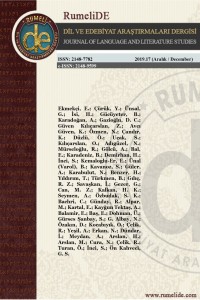Abstract
The existence of poetry is nearly as old as the existence of language itself. Since the last millennia, with the inception of translation studies the relationship between poetry and translation has been a controversial issue. While translation facilitates linguistic and cultural transfer, poetry which can be described as subliminal power of language, embeds additional elements influencing the reader’s interpretation. Therefore, within the context of literary translation, the need to transform the cogitation that the poem offers to the reader makes poetry translation an even more challenging task for the translator. The aim of the present study is to examine the major problems faced when translating the prominent 20th century poet Atilla İlhan’s poem ‘Döşeme’ from Turkish into English. Metaphor is the first and foremost problem that İlhan’s poetry constitutes for the translator because metaphor is a prevalent and predominant feature of the poem under investigation. The second problematical area dealt with arises from the lexical items employed by İlhan, and the cultural constraints that these items bring to the translation process. The study also deals with the attempts to overcome the problems of metaphors and lexical items faced when translating İlhan. As this study indicates, translating the Atilla İlhan into English is a challenge.
Keywords
References
- Aksoy, B. (2018). Personification of the Non-Human as Symbols of Love in Atilla Ilhan’s Poetry. Lyuboslovie, (8): 154-161. Burmakova, E. A. & Marugina, N. I. (2014). Cognitive Approach to Metaphor Translation in Literary Discourse. Procedia – Social and Behavioral Sciences, 154, 527–533. Dagut, M. (1987): "More about the Translatability of Metaphor". Babel, 33 (2): 77-83. Hoang, H. (2014). Metaphor and Second Language Learning: The State of the Field. TESL-EJ, 18 (2). Kurth, E. (1999). “‘Altered Images,’ Cognitive and Pragmatic Aspects of Metaphor Translation” in J. Vandaele (ed.), Translation and the Re(Location) of Meaning, 97-116. Leuven: University of Leuven. İlhan, A. (2006). “Döşeme”, Duvar. İstanbul: Türkiye İş Bankası Kültür Yayınları, 15th edition. Larson, M. L. (1984) Meaning-Based Translation A Guide to Cross-Language Equivalence. Lanham, (MD): University Press of America Mason, K. (1982). Metaphor and Translation. Babel, 28 (3), 140 − 149. Newmark, P. (1988). A Textbook of Translation. U.K.: Prentice Hall International Nida, E. A. (1964). Towards a Science of Translating, with Special Reference to Principles and Procedures Involved in Bible Translating. Leiden: E. J. Brill. Van den Broeck, R. (1981). The Limits of Translatability Exemplified by Metaphor Translation. Poetics Today. Vol. 2, 73–87. Venuti, L. (1995). The Translator’s Invisibility. Routledge. London.
Atilla İlhan’ın şiirini çevirirken karşılaşılan sorunlar: “Döşeme” şiiriyle ilgili örnek olay incelemesi
Abstract
Şiirin varlığı, dilin varlığı kadar eskidir. Çeviri araştırmalarının başlamasıyla birlikte şiir ve çeviri arasındaki ilişki tartışmalı bir konu olmuştur. Çeviri, dilsel ve kültürel aktarımı sağlar oysa dilin bilinçaltı gücü olarak nitelendirilebilecek olan şiir, okuyucunun düşünme biçimini etkileyen diğer unsurları da barındırır. Bu nedenle, edebi metin çevirisi bağlamında, şiirin okuyucusuna sunduğu bu düşünce unsurlarının da erek dile aktarılması gerektiğinden, şiir çevirisi daha da zorlu bir görev olmaktadır. Bu çalışmanın amacı, 20. yüzyıl seçkin Türk şairi Atilla İlhan’ın ‘Döşeme’ adlı şiirini İngilizce’ ye çevirirken karşılaşılan sorunları irdelemektir. İlhan'ın şiir çevirisinde karşılaşılan ilk belirgin sorun eğretileme sorunudur, çünkü bu İlhan’ın en yaygın ve belirgin özelliğidir. Özel olarak ele alınan öbür sorunsal alan ise, İlhan'ın kullandığı sözcükler ve bu sözcüklerin çeviri sürecine getirdiği kültürel sınırlamalardır. Çalışma aynı zamanda, Atilla İlhan'ı çevirirken özel olarak karşılaşılan eğretileme sorununa değinmekte ve karşılaşılan bu sorunların üstesinden gelme denemelerine yer verir. Bu çalışmada da görüleceği gibi Atilla İlhan'ı İngilizce’ ye çevirmek zorlu bir uğraştır.
Keywords
References
- Aksoy, B. (2018). Personification of the Non-Human as Symbols of Love in Atilla Ilhan’s Poetry. Lyuboslovie, (8): 154-161. Burmakova, E. A. & Marugina, N. I. (2014). Cognitive Approach to Metaphor Translation in Literary Discourse. Procedia – Social and Behavioral Sciences, 154, 527–533. Dagut, M. (1987): "More about the Translatability of Metaphor". Babel, 33 (2): 77-83. Hoang, H. (2014). Metaphor and Second Language Learning: The State of the Field. TESL-EJ, 18 (2). Kurth, E. (1999). “‘Altered Images,’ Cognitive and Pragmatic Aspects of Metaphor Translation” in J. Vandaele (ed.), Translation and the Re(Location) of Meaning, 97-116. Leuven: University of Leuven. İlhan, A. (2006). “Döşeme”, Duvar. İstanbul: Türkiye İş Bankası Kültür Yayınları, 15th edition. Larson, M. L. (1984) Meaning-Based Translation A Guide to Cross-Language Equivalence. Lanham, (MD): University Press of America Mason, K. (1982). Metaphor and Translation. Babel, 28 (3), 140 − 149. Newmark, P. (1988). A Textbook of Translation. U.K.: Prentice Hall International Nida, E. A. (1964). Towards a Science of Translating, with Special Reference to Principles and Procedures Involved in Bible Translating. Leiden: E. J. Brill. Van den Broeck, R. (1981). The Limits of Translatability Exemplified by Metaphor Translation. Poetics Today. Vol. 2, 73–87. Venuti, L. (1995). The Translator’s Invisibility. Routledge. London.
Details
| Primary Language | English |
|---|---|
| Subjects | Creative Arts and Writing |
| Journal Section | Turkish language, culture and literature |
| Authors | |
| Publication Date | December 21, 2019 |
| Published in Issue | Year 2019 Issue: 17 |

